Calumet Bowens QuickRing — Speed Ring with Swivel Arm for Mounting Photographic Softboxes — a Review
© 2013 Peter Free
04 June 2013
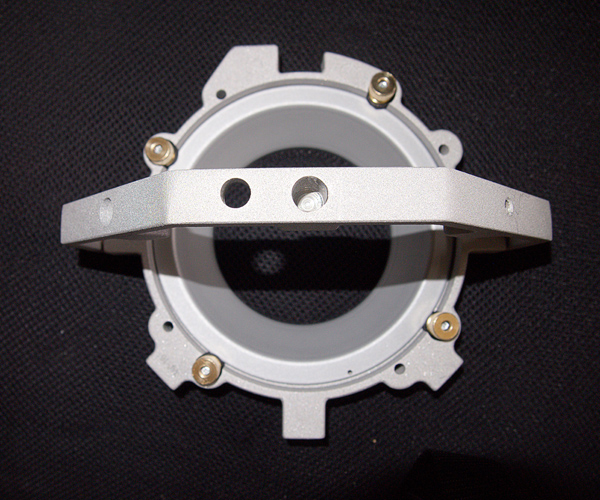
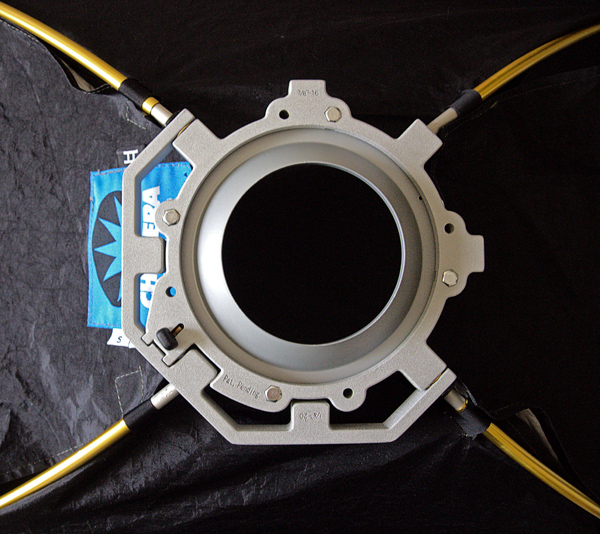
Limited utility
This 6-hole Calumet QuickRing speed ring — also known as a Bowens Quickring — is limited to its full design potential on only square or rectangular 4-rod or symmetrical 6-rod softboxes.
The QuickRing will NOT work (at all) on octaboxes because it has too few rod-receiving sockets.
Nevertheless, there are notable positives
The QuickRing is reasonably well made and the strobe-specific adapter portion of it is one of the best designs that I have seen.
When the QuickRing is used with Calumet’s Illuma softboxes (apparently a Plume Lighting knock-off), the QuickRing works admirably well. Part of its facility appears to be due to the Illuma’s fragile rods, which — unlike the Chimera’s that I discuss below — bend easily.
Mounting the adapter ring to the QuickRing
The adapter ring is held in position on the QuickRing by four circular brass knurled nuts. These sit atop four small spring loaded bolts.
Each bolt holds two composite material washers. The idea is that the strobe-specific circular adapter ring will be sandwiched between the two washers and secured to the QuickRing by the brass knurled nuts.
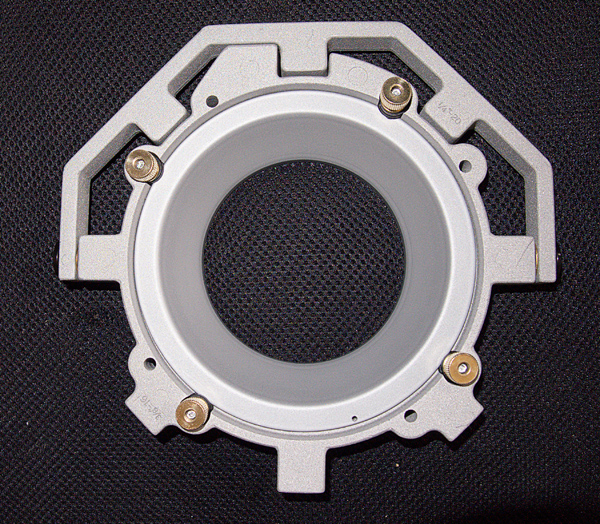
To mount your adapter, simply loosen two adjacent nuts and move the upper washer of each upward to leave a gap through which the bolt-surrounding spring can be seen.
Remove the two remaining adjacent nuts and their upper washers.
Drop in your adapter ring, being careful to seat it between each bolt’s two washers. Reattach the two nuts that you had removed and tighten everything enough to secure the adapter in place, but loosely enough to retain the adapter’s ability to spin.
This part of the QuickRing is an elegant design that seems to work well.
Negatives — discussed in regard to mounting a large Chimera strip box (rather than a Calumet softbox)
The QuickRing appears to work best with Calumet (and probably Bowens) softboxes.
However, I first assembled it using a large Chimera strip box, which apparently “wanted” to orient its rods slightly differently than the Calumet Illuma box that I mounted afterward.
I’ll discuss the Chimera experience first because it probably is indicative of what users will face using other intentionally sturdy softboxes that use relatively stiff aluminum rods:
(1) The asymmetrical socket locations on the QuickRing design lack self-explanatory virtue.
(2) No instruction manual is provided.
(3) The swivel feature gains nothing (in my experience) over the much cheaper, more versatile, and better thought out OEC EZstand speed ring that I reviewed, here. That ring, by the way, will mount octaboxes.
Be prepared for a bit of initial puzzlement
The QuickRing forces the first time user to think a bit about:
(a) which holes were intended for softbox rods
and
(b) how to space those rods, once the appropriate sockets are discovered.
The problem begins with the fact that the QuickRing holes are not all identical. Consequently, one intuits that they were intended for different purposes. But it takes a few minutes of experimentation to explore what was intended to what and how.
For example, the two threaded holes in the QuickRing are labeled:
1/4” - 20 (the twenty denoting the bolt thread twist)
and
3/8” – 16 (which is large enough in diameter to accept some brands of softbox rods).
These threaded holes are presumably supposed to parallel the OEC EZstand’s ability to be mounted directly to a tripod or light stand bolt — thereby allowing photographers to reduce some of the weight that the strobe mount itself would otherwise have to carry.
However, unlike the OEC EZstand, the QuickRing is not wider under the threaded holes. This, to my mind, somewhat defeats the purpose of allowing the ring to be directly mounted to a tripod or stand bolt. The QuickRing is too narrow at these mounting points to be ideally trusted with a heavy modifier. This is especially the case with the 1/4 inch hole, which would put too much stress directly on the attaching bolt.
In contrast, look at the width of the EZstand’s mount in the picture of it attached to my review.
Moving on to more appropriate-looking socket holes, one notices that the half-ring swivel arm pivots on pins that are themselves capped with black plastic-lined sockets. These black sockets’ top edges noticeably protrude from the surface of the QuickRing. On initially wonders whether these two sockets are supposed to accept rods.
Another, less likely looking hole is devoted to the spring locking plunger that secures the swivel portion of the ring to its final fully mounted position. Release the plunger, and you can pull the swivel arm forward to ease inserting the softbox rods. Obviously, this hole is not for rods.
To mount a 4-rod softbox, begin by inserting one rod into one of the black plastic sockets. Then mount the diagonally opposite softbox rod into the other black plastic socket. If you screw this step up, the QuickRing will not work.
After doing this, wrestle one of the remaining rods either into the hole on the swivel arm, or into the remaining hole on the non-moving portion of the QuickRing. It seems not to matter which you do first.
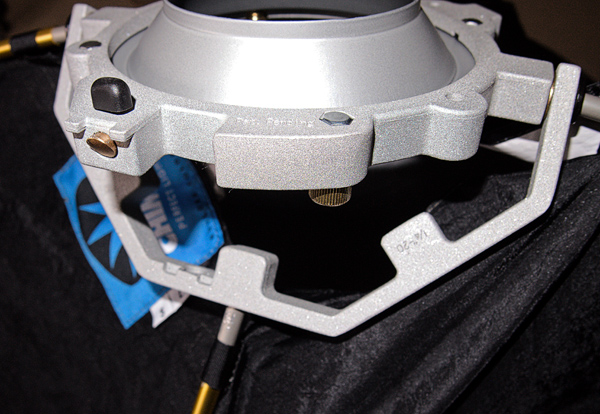
The hard part of the process (when using stout softbox rods) is getting the fourth rod into the ring, even when the swivel arm is pivoted to its forward (unlocked) position. Once the rod is properly seated, it is not especially difficult to force the swivel arm back into the locked position.
From my (possibly ignorant) perspective, the QuickRing merely moves the mounting difficulty to a position earlier in the process. For example, I saw no substantial benefit to using the QuickRing’s swivel arm, as opposed to taking advantage of the OEC EZstand’s 15 degree inclined sockets. With both gadgets, you are going to be wrestling with at least one rod sometime during the process.
Both systems work, but OEC’s is way cheaper and works for octaboxes.
On the other hand, the QuickRing works admirably on Calumet’s Illuma softboxes
I found that the Illuma’s obviously fragile rods bend easily. And, being smaller than the Chimera’s rods at the speed ring end, they fit more easily into the QuickRing’s sockets.
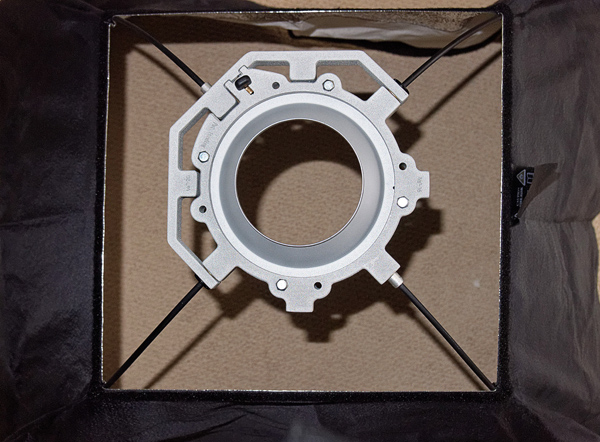
Durability?
Using the Chimera’s stiff aluminum rods, the QuickRing’s black plastic socket inserts — which cap the swing arm pivots — seem likely to crack, unlike the other four aluminum sockets.
I do not see the purpose to mixing materials in this fashion. If reducing friction was the aim, then Bowens Calumet should have used plastic inserts on all the sockets.
That said, the Illuma rods are so flexible (and reportedly breakable) that they are likely to bite the dust before the QuickRing’s plastic sockets do.
Calumet Bowens QuickRing is only half-heartedly recommended
If you are exclusively using Calumet (and probably Bowens) softboxes, the QuickRing works admirably.
But if you are using other brands of softboxes, especially those with heavier duty aluminum rods like Chimera’s, I see no advantage to the QuickRing over the OEC EZstand, which allows one to mount 4, 6, and 8-rod softboxes.
The benefit of the elegantly thought out, easily changeable adapter mount on the QuickRing diminishes substantially because the ring can only be used on a subset of softbox designs. If you use octaboxes at all, you are going to need another speed ring to mount them.
Elinchrom’s octabox-capable Rotalux speed rings visually seem to me (not yet having used one) more versatile. They will mount 4, 6, and 8-rod boxes. And there is no confusion at all as to how they are supposed to work.
On the other hand, the Elinchrom design may require too much finger force because each socket pivots on its own axis. Elinchrom’s individual socket design reduces the leveraging advantage that the longer Bowens Calumet swivel arm allows the user to exert. This might be a problem, especially for people who have arthritis in their hands and fingers.
Additionally, Elinchrom’s pictures of its speed ring cause me to question whether its sockets are large enough to accept other softbox manufacturers’ rods.
All told, I would sooner buy another OEC EZstand speed ring than the Bowens Calumet attempt.
The OEC version of a speed ring is cheaper and cruder, but more versatile and far less likely to fail — since it has no moving parts, other than allowing the steel adapter ring to spin.
There are people who disagree with me. One is Marlon at Quick Twist Photography.
He lauded the QuickRing in his helpful video regarding it on YouTube, here.
Note
Busy people will think that Marlon included too long an introduction to the topic. They should skip to the most pertinent segment of the video, beginning at the 2:35 minute mark.
Marlon, however, appears to be mounting more flexible rods into his QuickRing than those that characterize Chimera’s products. So, I rest with the implication that the QuickRing works best on the softboxes that it was apparently designed to serve.
 PeteFree.com
PeteFree.com